Today is winter solstice, here down south. The day was warm and sunny, and brightened by the winter-flowering plants. Even though we don’t suffer from frigid temperatures I still appreciate that from tomorrow, the days will start lengthening, albeit imperceptibly at first.
Historically at least, we live in a summer-rainfall region. Some relief from the harshness of dry winters arrives in the form of the winter-flowering aloes. Their flowers bring food to pollinators, birds and other creatures.
In our garden we have two freely flowering aloes. One is the easy-going Fence Aloe (Aloiampelos tenuior – previously Aloe tenuior), with its slender sprawling branches, and long slender flowers. In the wild they find support on neighbouring vegetation. In gardens they are often grown on fences, hence their name.

Our winter-flowering Fence Aloe (Aloiampelos tenuior) was trained simply by winding it between the wires to climb the fence of our cats’ garden
In the wild, the Fence Aloe grows from sea level through to the mountains in a variety of habitats through much of the southern and eastern regions of South Africa. The flowers on the plants in our garden are a cheerful yellow. Forms with orange or red flowers also occur naturally.
The scientific name for the Fence Aloe used to be Aloe tenuior. However, with a revised classification of the genus Aloe in 2013, a genus for climbing aloes was added. The name Aloiampelos means ‘climbing aloe’. The tenuior part of the name refers to the slender branches.
The Fence Aloe is primarily pollinated by bees, but butterflies and birds are also attracted to the flowers.

A Streaky-headed Seedeater, in the glare of the midday sun, attracted to our garden to eat the flowers of the Fence Aloe
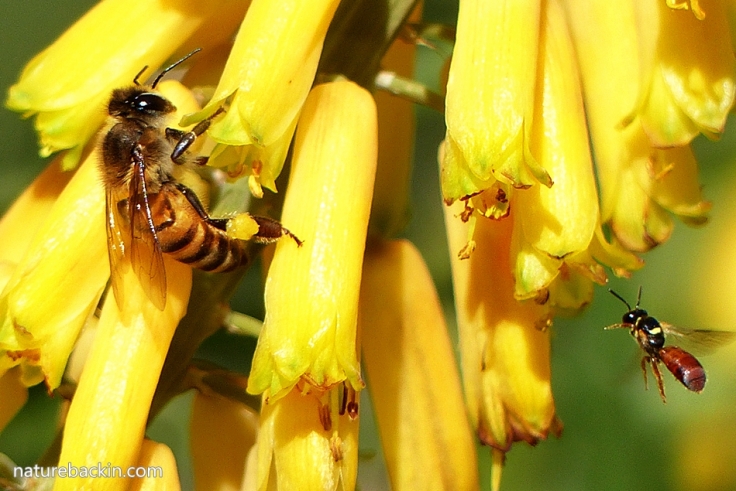
In this close-up of Fence Aloe flowers are two kinds of pollinator, a honeybee on the left, and on the right a tiny bee that is native to southern and eastern Africa
I spent some time trying to identify the tiny pollinator in the photo above. I wondered if it was a wasp masquerading as a bee, but I think it is a species of solitary bee named Allodapula variegate. The information I could find on this little bee is sparse, but I gather that it makes a nest for its larvae in hollow stalks or dead wood.
The Fence Aloe is easy to grow. If it needs trimming back, any cuttings stuck in the ground take root easily. Its slender gracefulness and cheerful flowers brightened up my private celebration of winter solstice this morning.
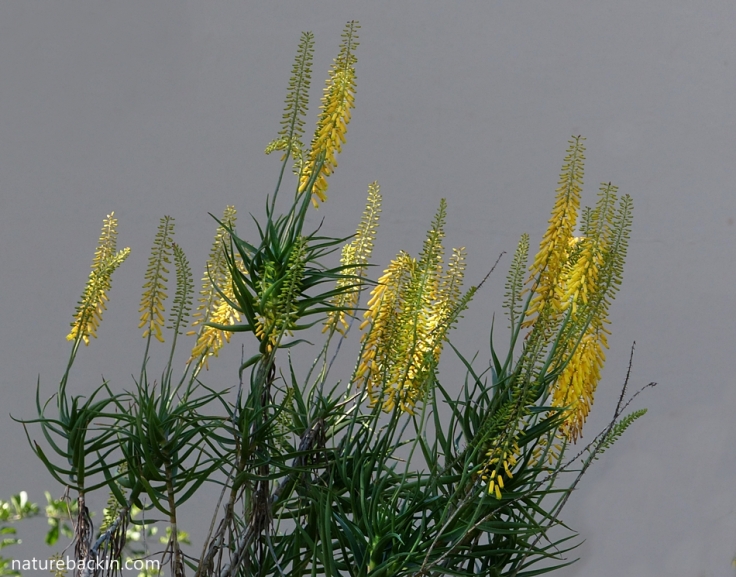
The Fence Aloe extending high above the fence that supports the base of the plant. With some support it can grow to a height of about 3 metres
Rather more showy, is the Krantz Aloe (Aloe arborescens). It is also widely distributed in South Africa (mostly in the summer rainfall areas), is adapted to many habitats and is also free flowering in the winter months. Its common name reflects the fact that it is often found on rocky outcrops or ridges.
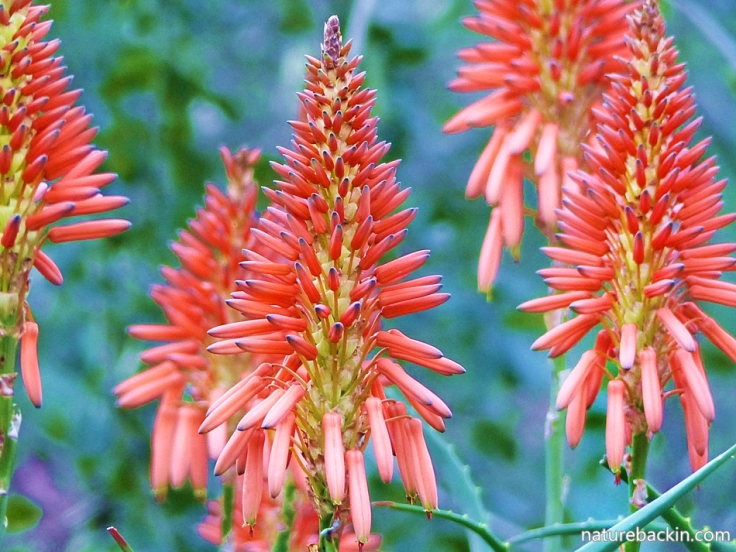
The Krantz Aloe flowers abundantly, its flowers making a cheerful show brightening up even chilly winter days
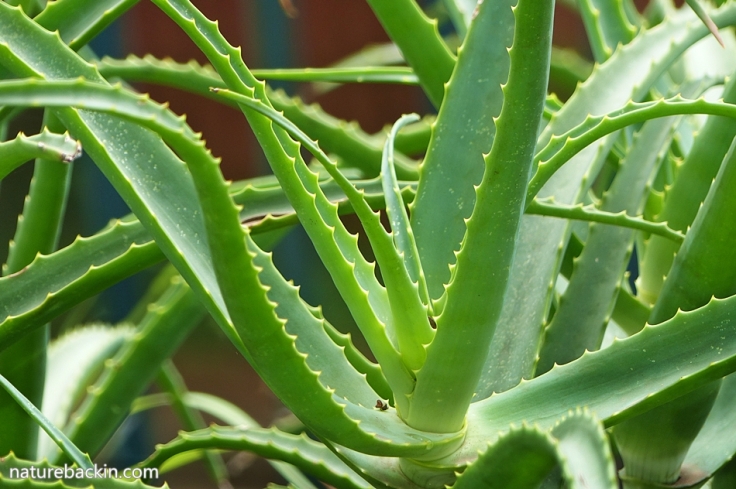
The robust and fast growing Krantz Aloe is often grown as a hedge, traditionally around domestic stock enclosures
This South African aloe is cultivated across the world. It was one of the first aloes collected by Dutch settlers in the Cape, and it was taken to Holland and grown in Amsterdam as far back as 1674. Its scientific name, Aloe arborescens, suggests that it is tree-like, but the arborescens part of the name was conferred with reference to its stem-forming habit.

A flower spike of the Krantz Aloe in the early stages of its development. Orange is the most common colour, but a yellow form is also found
Many aloe plants are known for their medicinal properties. Traditionally in South Africa decoctions from the leaf of the Krantz Aloe have been used medicinally. Extracts from the leaves have been found to have wound-healing and anti-inflammatory properties, and anti-ulcer, anti-carcinogenic, and anti-diabetic effects. Gel from the leaves is used to treat burns and wounds. It was used to treat irradiation burn wounds on victims of the atomic bombs exploded in Japan in World War II.

The fully opened flowers of the Krantz Aloe provide nectar for honey bees and other pollinators
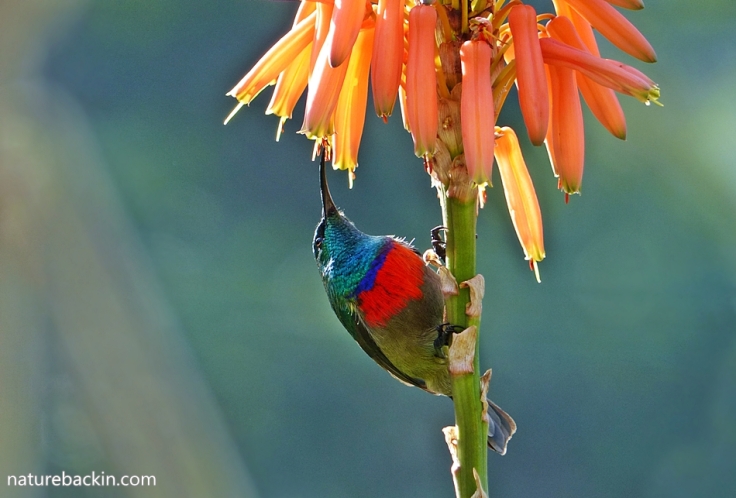
The flowers are also sought out by sunbirds, including this Double-collared Sunbird
So, as today is winter solstice, in the southern hemisphere from tomorrow we can theoretically at least begin the countdown to spring, even though the usually colder winter months are still ahead of us. We can only hope that spring brings with it the rains that are so desperately needed in many of the summer-rainfall regions of the country.
Sources: Ben-Erik van Wyk and Nigel Gericke. 2007. People’s Plants: A Guide to Useful Plants of Southern Africa. Pretoria: Briza; South African National Biodiversity Institute (SANBI). 2001 updated 2004. Aloe arborescens. http://pza.sanbi.org/aloiampelos-tenuior; South African National Biodiversity Institute (SANBI). 2002, updated 2016. Aloiampelos tenuior. http://pza.sanbi.org/aloiampelos-tenuior
Posted by Carol






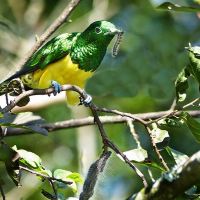
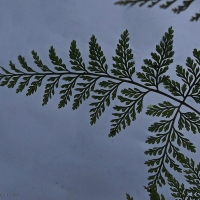
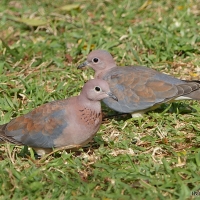
June 26, 2018 at 12:15 pm
These photos are absolutely gorgeous! I especially love the first shot with the bee and pink pollen.
-Emma
LikeLiked by 1 person
June 26, 2018 at 9:16 pm
Thanks Emma. Yes, I also noticed that the pollen was pink 🙂
LikeLiked by 1 person
June 26, 2018 at 8:52 am
So common to us in South Africa, but seen through your lens, like always, so much more spectacular.
LikeLiked by 1 person
June 26, 2018 at 9:15 pm
Thanks Suzette 🙂
LikeLike
June 24, 2018 at 6:39 am
Such beautiful shots!
LikeLiked by 2 people
June 26, 2018 at 9:14 pm
Thanks Simone.
LikeLiked by 1 person
June 23, 2018 at 12:23 pm
Beautiful shots, Carol, and fascinating information as always.
LikeLiked by 1 person
June 23, 2018 at 12:49 am
How lovely that you can celebrate the days getting longer, while I start feeling a touch of dread at the shortening days here. For much of my adult life I’ve had an aloe plant (indoor Krantz variety would be my guess), but it has never given me the pleasure of seeing it bloom. How wonderful to see it grow so happily and to bloom so beautifully.
LikeLiked by 1 person
June 26, 2018 at 9:14 pm
Well, I hope that you enjoy the summer months that still lie ahead, even with the shortening days. I wonder what may induce your potted aloe to flower. Perhaps it just can’t find enough winter sunshine in your neck of the woods?
LikeLike
June 27, 2018 at 2:02 am
I’ve never known of an aloe to flower over here. They’re mostly potted and kept inside because of our very wet winter seasons, so I think your guess would be right that they don’t get enough sun. Even so, they are handy to have around (for scrapes and burns) and they’re lovely even when not blooming.
LikeLiked by 1 person
June 22, 2018 at 3:34 pm
Beautiful post, Carol.
We have the Kranz but not the Fence. I must make inquiries.
Super shot of the Double Collared.
LikeLiked by 1 person
June 26, 2018 at 9:05 pm
Thanks Ark. Hope you manage to find a Fence Aloe.
LikeLike
June 22, 2018 at 9:08 am
A fine celebration in aloes, Carol. That yellow fence aloe is stunning. I’ve never seen a yellow one before. It evoked a rush of gardener’s lust, though not the place for them in Much Wenlock.
LikeLiked by 2 people
June 26, 2018 at 9:04 pm
Thanks Tish. I was surprised to learn how many places aloes are grown, but you do have a gorgeous array of plants that thrive where you are.
LikeLiked by 1 person
June 22, 2018 at 7:22 am
The Double Collared Sunbird is just wonderful with its iridescent colours.
LikeLiked by 2 people
June 26, 2018 at 8:58 pm
Yes it is a particularly gorgeous little bird.
LikeLiked by 1 person
June 22, 2018 at 6:51 am
That was interesting as these plants are pretty much unknown here (well, to me anyway). The photos that include appreciative animal and bird life are particularly lovely.
LikeLiked by 1 person
June 26, 2018 at 8:57 pm
Thanks Margaret. The flowers provide much for them to appreciate 🙂
LikeLiked by 1 person
June 22, 2018 at 4:44 am
I am interested in the change of name you mention for the Aloe tenuoir. My Guide to the Aloes of South Africa by Ben-Erik van Wyk and Gideon F. Smith, published in 2014, doesn’t mention it. Lovely photographs as always – funnily enough, we took a drive out only yesterday to look at aloes in the veld, which I intend to feature soon 🙂
LikeLiked by 1 person
June 26, 2018 at 8:56 pm
I first picked up on the change of name on the SANBI website. Apparently the tree aloes now also have a separate genus. Nice to think of the aloes blooming across the country.
LikeLike
June 22, 2018 at 2:18 am
Such gorgeous flowers – your photos are wonderful, Carol!
LikeLiked by 1 person
June 26, 2018 at 8:53 pm
Thank you Eliza.
LikeLike
June 22, 2018 at 1:04 am
Sure to cheer up the dreariest of winter days!
LikeLiked by 1 person
June 26, 2018 at 8:52 pm
Glad you think so too 🙂
LikeLiked by 1 person
June 21, 2018 at 11:40 pm
Quite an attractive array of aloes. I really like the fence aloe.
And as your days begin to grow longer and gradually warmer, ours grow shorter
and eventually cooler.
LikeLiked by 1 person
June 26, 2018 at 8:51 pm
Yes, when I wrote the post I was mindful of the opposite prospects for the northern half of the globe. But you do still have the best of summer to enjoy.
LikeLiked by 1 person
June 27, 2018 at 1:48 am
Yes, there are many warm days ahead of us.
LikeLiked by 1 person
June 21, 2018 at 10:58 pm
Very nice photos as always, especially the sunbird and bees. And what cheerful flowers.
LikeLiked by 1 person
June 26, 2018 at 8:48 pm
Thanks. The long-lived flowers are especially cheerful in the dry winter drabness.
LikeLike